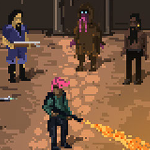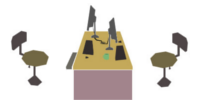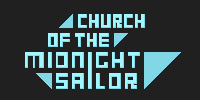Interview: Death Trash’s Stephan Hövelbrinks
For lovers of pixel art, post-apocalyptic settings, and fast-paced combat, dark humor and grotesque cyberpunk survival combine to make Death Trash a project that blows minds and inspires a following. I chatted with Stephan Hövelbrinks, the force behind the game’s design, art, and coding, noting his attention to detail and careful crafting of features.
Erik Meyer: You cite Planescape: Torment, Fallout, and Ultima 7 as influences, and the game exists as a gritty, post-apocalyptic mystic world. That said, the play style (dialogue, combat) appears decidedly faster paced than the turn-based titles of the past that used dialogue tree screens and hex movement, so what mechanics and nuances of past RPGs do you wholeheartedly embrace as a developer, and where do you see Death Trash evolving and pushing the genre?
Stephan Hövelbrinks: What I take as main influences from these older games is the intricate world building, the player freedom and being on an adventure, all together forming a coherent experience. The “being on an adventure” one I realized as important to me only lately, but having that in mind, I know now why I favor roleplaying games that have a good balance of elements over ones that focus on specific elements like tactical combat.
It is exactly the pacing and the balance of elements where I hope Death Trash can push the genre a bit. There are many titles where parts of it make it less attractive to me: Too many lootable items and the game becomes inventory management, micro-managing companions instead of focusing on the experience with your own character, too many cutscenes instead of player agency, too many places that feel similar instead of moments that stand out. Not saying those are bad games, far from it, but I would like to focus more on memorable moments than having a huge amount of everything, but everything feels a bit samey.

EM: Locations include caverns filled with pulsating flesh beasts, taverns crawling with hobos, and landscapes packed with sci-fi scavengers and killing machines, yet you’re focused on world simulation and storytelling, so can you expand on the personal manifest you wrote to guide you in stitching together the game’s experiences? From a narrative point of view, what do you see as effective and essential in establishing depth, especially in a brutal world? Alternatively, what do you feel takes players out of games (and should thusly be avoided), from a plotting standpoint?
SH: It’s more about my gut feeling than rules that let me decide what goes into the world and what not. The elements of Death Trash sound very random at first, but to me there’s a strong coherence. Depth comes from having a lot of elements and themes, but the player also being able to relate to them, seeing the lines that connect them. So one theme of Death Trash is the feeling of humanity contrasted against a harsh, sometimes alien environment. And this manifests in most characters being humans and not mutant weirdos, using low-tech equipment like shotguns, but it also manifests in a good number of the cosmic horrors in the game having personality, being talkative, even craving humanity. The theme happens on multiple layers.
What takes players out of games are outside references. Nothing destroys the believability of your world as fast as Easter eggs, however fun they might be. It always takes away from the experience encountering an item or a character that does not belong to this specific world.
EM: I’m a nerd for skills and attributes, so while you have some conventional skills (lockpicking, guns, movement speed), you also have some unexpected areas to foster (artistry, sex, flesh). As you settled on the different options and interactive game elements, what was the process for deciding what to include (i.e. crafting, pickpocketing, etc), and how did the less typical elements get included and developed?
SH: The attributes and skills are still work in progress.
Direct gameplay elements (shooting, sneaking) get developed first in tandem with the world building, then abilities the player can use to boost, augment, and support these situations, then we come up with the roleplaying stats. I think of the roleplaying system as this cohesive material, holding everything together, filling the holes, giving a journey of character progression over the course of the game. And while it’s an important element of the game, it’s much easier to adjust it to the core gameplay than it would be the other way around.
Some of the skills just derive from the three gameplay variants, combat, stealth and talking, so I would say they derive from the genre and are therefore more traditional. The more exotic ones derive from the themes of this specific world. But they are also the most volatile yet because they need more design work than traditional ones.
I try to pick skills from the themes of Death Trash that make the setting more unique, ones that totally make sense in this world but you wouldn’t necessarily find in other scenarios.
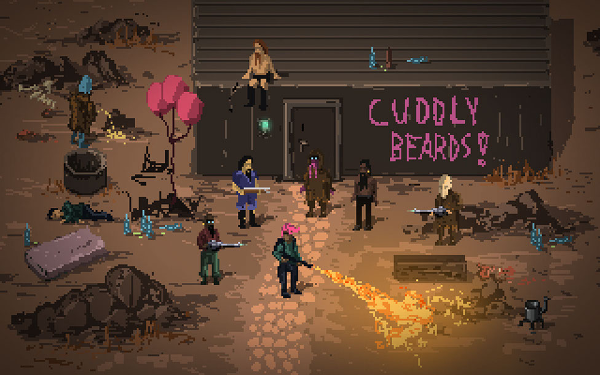
EM: The pixel art you’re creating will attract gamers on its own, but you aren’t simply making games the way they were made 30 years ago; you’re using water shaders and UI elements (for example) that come with the advantages of a modern engine, so can you speak to the schism therein? As gamers, we remain nostalgic for the titles of yesteryear, but I’m guessing we wouldn’t feel that way about the development tools. In terms of current software, what have you held as key criteria for your development environment?
SH: I’m not interested in maintaining or respecting the legacy of pixel art. Being playful with the style, experimenting while still maintaining coherence, should be allowed without such restrictions.
When it comes to development tools, I favor efficiency over everything. I’m a single developer, so time is precious, and if I find a tool that lets me make a lot of stuff in a short amount of time, that’s more important to me at first than more features or even runtime performance. Also important is the ability to iterate a lot, because most often the first version of a component isn’t the final one. That means, for example, that the pipeline for updating the art assets of the game has to be fast and easy.
Regarding software, the sweet spot for me right now is with Unity (cross-platform), C# as a programming language (solid, powerful) and a combination of Aseprite and Photoshop for the art. Death Trash has a lot of custom tools, too, e.g. the level editor. It’s a huge time investment at first, but it will make the following stages of the project much easier to handle than without them. And there’s a good chance that these will be published at a later point so other people can create levels and mods for Death Trash.
EM: Beyond the current project, you clearly harbor a deep love of pixel art, so I’m interested in your views of the genre, given its connection to computer graphics, ’80s aesthetics, and the current resurgence within indie games. What is it about an ability to make distinctive shapes in 16X16 squares that makes the style so compelling?
SH: The compelling aspect of pixel art comes from the viewer herself being part of the experience, shaping it in the mind, whereas with high definitions, the image is already complete when it arrives in the mind of the viewer. In that regard, it’s very similar to other reduced art styles like low poly or many hand-drawn styles.
Much of the fascination with pixel art for myself comes from the process of creating it. I can create similar experiences with other art styles, but pixel art is so much faster, so flexible, and gets a strong coherence just through that low resolution grid.
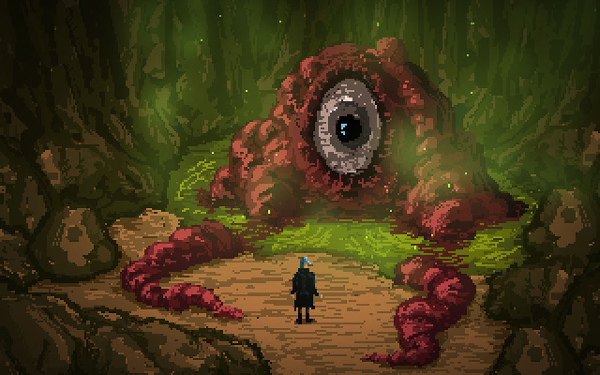
EM: I’m curious about the style of play you intend to cultivate through local co-op because of the game’s many elements (crafting, etc); the ability to play with a community of friends feels like a big selling point. That said, how does the inclusion of multiple players change the levels you’re designing and/or the AI/enemies?
SH: I should mention that the co-op mode was always more of an experiment or an “wouldn’t it be nice if”, but I just kept working on it. And it’s integrated pretty good now, but as most of the level building is still ahead of me, I’m not sure yet how it will change the levels. My main interest is allowing the co-op experience in the first place, wandering through a world, experiencing it together. Like I want to play together with my wife in a lot of games but just can’t. Balancing the gameplay for two players comes second. I’m sure I will spend a good amount of time on that, too, but for now, it’s not my main focus and I can’t say for sure how it will shape enemy count, stats, and paths through a level.
EM: Do you view Psi powers as a way to include magic in a sci-fi world, or do you take a more restricted view of what mental abilities can accomplish? What rules, from a development standpoint, have you created to govern the abilities you would grant to players?
SH: The Psi powers are definitely more akin to magic than having restrictions bound in science. I call them Psi because that’s a contrast to the other elements of the world, which are more bounded in physical reality.
There are no hard boundaries for creating abilities in the world of Death Trash. Similar to settings like Planescape, words and dreams of powerful entities should be able to create or shape places and experiences. And if that’s possible, the player should have some of that power, too. But while the possibilities are endless, I try to limit the supernatural so the whole experience has still enough grounded, down-to-earth elements and doesn’t feel like a weird chaos.
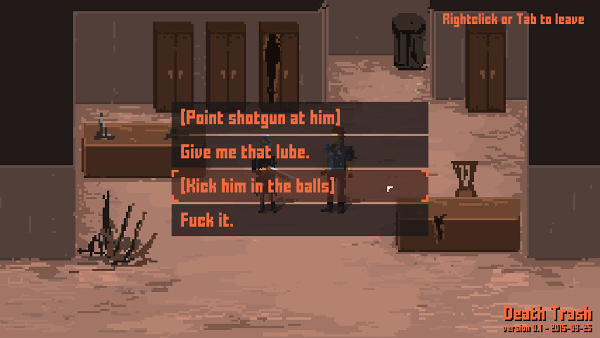
EM: What are the biggest elements of the game and its implementation that you’ve had to revise as you’ve gone along? As a developer, what kinds of things have shifted your design/gameplay balance focus, and what does your pipeline look like, moving forward?
SH: There’s a lot that changed over the course of development. Combat, for example, saw a lot of changes. But that was kind of expected as I started this game with a world in mind, and I knew it would need some iterations on the gameplay.
The project in general is a huge learning experience. Almost daily I encounter tasks I haven’t tackled before, and almost always I have to come up with my own solutions. Be it for programming, art, communicating on social media, etc.
With the framework and tools feeling good now, the pipeline is pretty much set on creating and designing the world and levels. I do hope to get some collaboration there in the future and that will probably need more adaptation on my side, too.
In case you missed the prototype video from several years ago (note, another video is coming soon), here it is:

